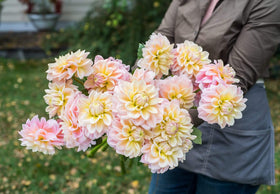Each flower brings its own quiet rhythm. Some prefer a generous drink, others thrive with restraint. Here are some practical tips to extending the life of your flowers.
There’s something deeply satisfying about arranging flowers in your home—placing them just so, stepping back to admire. While many of us know to trim the stems and change the water, there are quieter details that can make a noticeable difference in how long those flowers stay with you. Water level, storage temperature, even something as simple as giving stems room to breathe—these small acts of care extend the presence of a bouquet.
The Deep Drinkers: Flowers That Appreciate a Full Vase
Some flowers do best with their stems well-submerged and their water refreshed frequently. A full vase offers not only hydration but support.
Roses benefit from a deep vase and a fresh trim every day or two. Cutting under water or placing them immediately into water after trimming can help them absorb more easily.
Lilies will last longer with generous water and clean conditions. Gently removing the pollen can keep both the flower and your linens looking lovely.
Hydrangeas thrive on both stem and petal hydration. If they start to droop, submerge the heads in water for a short while or try a quick dip of the cut stem in boiling water, then return it to a cool vase.
Dahlias need clean water and space—crowding encourages rot. Change the every other day but if you don't, you can add a drop of bleach to the water to help discourage bacteria. We don't add bleach as we find it unnecessary but the openness of the stem can cause more bacteria than other flowers.
Peonies benefit from a full vase to support their lush blooms. If they arrive closed, a warm room or brief soak of their heads in warm water can encourage them to open.
Sunflowers drink heavily the first few days. Zinnias benefit from a full vase of clean water and daily refreshing. As with dahlias, a touch of bleach is helpful if the water will not be changed frequently.
Removing foliage below the waterline helps keep things fresh for all flowers.
The Minimalists: Flowers That Prefer Just a Little Water
There are flowers that benefit from a lighter touch. These blooms last longer when the vase isn’t filled too high.
Tulips continue to grow after being cut. A couple of inches of water is enough to nourish them without encouraging droop. A tall vase helps provide support.
Gerbera daisies are sensitive to excess moisture. They do best in shallow water that’s changed often. Inserting a floral wire inside the stem can keep the bloom upright.
Irises prefer cool conditions and modest water, refreshed every day or so. They enjoy a little space to themselves.
Carnations are generally low maintenance—keep the water modest and clean, and trim as needed.
Cut orchids do best in very shallow water. They prefer a stable environment.
Simple Habits That Make a Difference
A few quiet adjustments can help flowers last longer without much effort at all.
Cool Rest, Not Cold
Some flowers benefit from overnight rest in a cool basement or air-conditioned room. Refrigeration works well for some varieties, but others—like dahlias, zinnias, and celosia—prefer warmth and decline if stored too cold.
Avoid Ethylene Exposure
Ripe fruit releases ethylene gas, which can hasten flower aging. Keeping flowers away from fruit bowls or produce drawers helps extend their vase life.
Homemade Flower Food
To create your own preservative, mix the following into a gallon of water: one tablespoon lemon juice, one tablespoon sugar, and a few drops of bleach. This helps feed the flowers while keeping bacteria at bay. It is not needed for all flowers but can benefit zinnias and sunflowers.
Trim and Refresh
Always cut stems at an angle to allow better water absorption. Recutting every few days helps keep water channels open. For woody stems, a vertical slit can improve intake.
Choose a Good Spot
Avoid placing arrangements in direct sunlight, near heat sources, or under air vents. A steady temperature and soft light suit most varieties best.
A Final Thought
Flowers don’t last because we force them to—they last because we notice. With a little attention to their natural preferences, flowers can linger far longer than expected, bringing quiet joy into the room each day they remain.





Thank you Great information!
Great info. Thx!
Well presented, Very helpful but lots to remember!